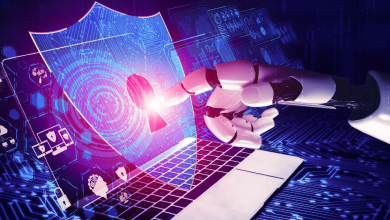
Every second, artificial intelligence analyzes billions of data points, hunting for the next cyberattack before it strikes. AI has become cybersecurity’s most powerful weapon — detecting threats in microseconds, automating responses that once took hours, and identifying deepfakes as quickly as they’re created.
Yet this revolution harbors a dangerous irony. The same centralization that makes AI infrastructure efficient also transforms it into the ultimate honeypot for sophisticated attackers.
When a handful of cloud giants control the computational backbone of our digital defenses, a single breach could cascade across thousands of organizations.
We need AI to remain our shield, but deployed through a decentralized infrastructure that matches the adaptability and resilience of the threats we face.
AI’s Cybersecurity Revolution
The numbers tell a compelling story about AI’s impact on digital defense. Automated threat detection systems now identify and neutralize attacks in under 30 seconds. It used to take hours for a team of analysts to accomplish the same thing. Machine learning models process network traffic patterns, user behaviors, and system anomalies simultaneously, catching subtle indicators that human experts might miss.
Consider the sophistication of modern AI-powered honeypots. These systems generate entirely convincing fake environments, complete with realistic data and user activity, drawing attackers into controlled spaces where their techniques can be studied and countered.
When cybercriminals develop new attack vectors, AI systems adapt within hours, not weeks. The same generative models creating chatbots and artwork now simulate potential breaches, helping organizations patch vulnerabilities before they’re exploited.
Deepfake detection exemplifies this technological arms race perfectly. As creation tools become more sophisticated, detection algorithms evolve in parallel. Financial institutions use AI to spot synthetic voices attempting wire transfer fraud. Media companies deploy neural networks that analyze pixel-level inconsistencies invisible to human eyes. The technology moves so fast that models trained last month already feel outdated.
This transformation extends beyond detection. AI orchestrates complex incident responses, automatically isolating compromised systems, rerouting traffic, and deploying patches.
The result?
Breach containment times have dropped from days to minutes.
The Centralization Trap
Beneath this defensive revolution lies an uncomfortable truth. Three cloud providers host nearly 70% of enterprise AI workloads. The same companies supplying the infrastructure also develop the leading security models. This concentration creates vulnerabilities that traditional cybersecurity frameworks never anticipated.
Think about the implications. When organizations rely on identical AI models from the same providers, they share common blind spots. Attackers who discover how to fool one system gain access to thousands of potential targets. The homogeneity that makes deployment simple also makes exploitation scalable.
History offers sobering lessons. The 2020 SolarWinds breach compromised a single software provider but impacted 18,000 organizations. Now imagine that scenario with AI infrastructure, where the compromise involves not just software but the very systems designed to detect and prevent attacks. The blast radius would be unprecedented.
Cloud providers acknowledge these risks, investing billions in security. Yet centralization remains centralization. No amount of security spending changes the fundamental mathematics: fewer providers mean fewer targets for attackers to study, and higher rewards for successful breaches.
New Attack Vectors in Centralized AI
The convergence of AI and centralization spawns entirely new categories of cyber threats. Model poisoning represents perhaps the most insidious. Attackers subtly corrupt training data to create backdoors that activate under specific conditions. When these models are distributed across thousands of organizations through centralized platforms, the contamination spreads silently.
Supply chain attacks take on new dimensions in AI pipelines. Compromising a data labeling service or training cluster provides access to influence models before deployment. These attacks bypass traditional perimeter defenses because they corrupt the defenders themselves.
Adversarial AI adds another layer of complexity. Attackers use their own AI systems to probe centralized models, discovering precise inputs that cause misclassification or system failures. With centralized infrastructure, these discoveries apply broadly. A vulnerability in one deployment often extends to all.
Perhaps most concerning: centralized AI systems become weapons when compromised. Imagine ransomware that doesn’t just encrypt data but actively uses an organization’s own AI defenses against it, or deepfake generators turned loose with access to internal communications. The infrastructure meant to protect becomes the attack vector.
The Decentralized Defense Model
Distributed AI infrastructure fundamentally changes the cybersecurity equation. Instead of concentrating compute power in massive data centers, decentralized networks spread processing across thousands of independent nodes. This architecture eliminates single points of failure while creating natural resilience against attacks.
The security advantages compound quickly. Attackers can’t study a single system to compromise thousands of organizations. Each node operates independently, making system-wide breaches virtually impossible. When one node faces compromise, the network isolates and continues functioning, much like the internet itself routes around damage.
Economic incentives align perfectly with security goals. Node operators earn rewards for contributing compute power, creating a marketplace where better security commands premium prices. This competitive dynamic drives continuous improvement without central mandates.
From Vision to Reality
Organizations exploring distributed AI demonstrate the potential. Consider a bank that moves its threat detection to a distributed infrastructure. It could reduce costs while improving response times by leveraging global compute resources.
The technology exists today. Modern orchestration tools abstract away complexity, making it possible for security teams to deploy distributed AI without overhauling existing infrastructure. Early implementations suggest performance can match or exceed centralized systems while offering superior resilience.
The path forward requires open standards enabling seamless interoperability between networks and security tools. Community governance structures would ensure no single entity controls the infrastructure that is defending our digital future. As more organizations experiment with these models, we’re seeing the emergence of a new security paradigm.
We stand at a crossroads. Continue down the centralization path, and we risk creating an AI-powered security apparatus vulnerable to catastrophic failure. Choose decentralization, and we build defenses that grow stronger under attack. The future of cybersecurity lies in distributed intelligence that adapts, evolves, and responds collectively to threats.
Our digital future depends on getting this right. The time to act is now.





